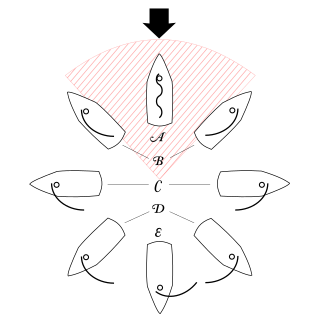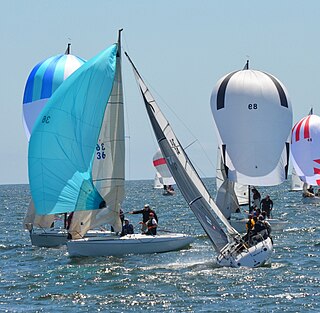The center of lateral resistance is the center of pressure of the hydrodynamic forces on the hull of a boat. The center of pressure is the point on a body where the total sum of a pressure field acts, causing a force and no moment about that point. The total force vector acting at the center of pressure is the value of the integrated vectorial pressure field. The resultant force and center of pressure location produce equivalent force and moment on the body as the original pressure field. Pressure fields occur in both static and dynamic fluid mechanics. Specification of the center of pressure, the reference point from which the center of pressure is referenced, and the associated force vector allows the moment generated about any point to be computed by a translation from the reference point to the desired new point. [1]
The relationship of the aerodynamic center of pressure on the sails of a sailboat to the hydrodynamic center of lateral resistance on the hull determines the behavior of the sailboat in the wind. This behavior is known as the "helm" and is either a Weather helm or lee helm. A slight amount of weather helm is thought by some sailors to be a desirable situation, both from the standpoint of the "feel" of the helm, and the tendency of the boat to head slightly to windward in stronger gusts, to some extent self-feathering the sails and pointing into oncoming waves. Other sailors disagree and prefer a neutral helm. [2]
The fundamental cause of "helm", be it weather or lee, is the relationship of the center of pressure of the sail plan to the center of lateral resistance of the hull. If the center of pressure is astern of the center of lateral resistance, the result is a weather helm, the tendency of the vessel to want to turn into the wind.
If the situation is reversed, with the center of pressure forward of the center of lateral resistance of the hull, a "lee" helm will result, which is generally considered undesirable, if not dangerous. Too much of either helm is not good, since it forces the helmsman to hold the rudder deflected to counter it, thus inducing extra drag beyond what a vessel with neutral or minimal helm would experience.
Other boats, including kayaks, are subject to the same phenomena. To counter this, they use a rudder or skeg. [3]

Sailing employs the wind—acting on sails, wingsails or kites—to propel a craft on the surface of the water, on ice (iceboat) or on land over a chosen course, which is often part of a larger plan of navigation.
The center of pressure is the point where the total sum of a pressure field acts on a body, causing a force to act through that point. The total force vector acting at the center of pressure is the value of the integrated vectorial pressure field. The resultant force and center of pressure location produce equivalent force and moment on the body as the original pressure field. Pressure fields occur in both static and dynamic fluid mechanics. Specification of the center of pressure, the reference point from which the center of pressure is referenced, and the associated force vector allows the moment generated about any point to be computed by a translation from the reference point to the desired new point. It is common for the center of pressure to be located on the body, but in fluid flows it is possible for the pressure field to exert a moment on the body of such magnitude that the center of pressure is located outside the body.
A skeg is a sternward extension of the keel of boats and ships which have a rudder mounted on the centre line. The term also applies to the lowest point on an outboard motor or the outdrive of an inboard/outboard. In more recent years, the name has been used for a fin on a surfboard which improves directional stability and to a movable fin on a kayak which adjusts the boat's centre of lateral resistance. The term is also often used for the fin on water skis in the U.S. It has been used for the vertical fin on seaplane hulls and floats.

The keel is the bottom-most longitudinal structural element on a vessel. On some sailboats, it may have a hydrodynamic and counterbalancing purpose, as well. As the laying down of the keel is the initial step in the construction of a ship, in British and American shipbuilding traditions the construction is dated from this event.

A point of sail is a sailing craft's direction of travel under sail in relation to the true wind direction over the surface.

A jibe (US) or gybe (Britain) is a sailing maneuver whereby a sailing vessel reaching downwind turns its stern through the wind, which then exerts its force from the opposite side of the vessel. For square-rigged ships, this maneuver is called wearing ship.

A daggerboard is a retractable centreboard used by various sailing craft. While other types of centreboard may pivot to retract, a daggerboard slides in a casing. The shape of the daggerboard converts the forward motion into a windward lift, countering the leeward push of the sail. The theoretical centre of lateral resistance is on the trailing edge of the daggerboard.

A centreboard or centerboard (US) is a retractable keel which pivots out of a slot in the hull of a sailboat, known as a centreboard trunk (UK) or centerboard case (US). The retractability allows the centreboard to be raised to operate in shallow waters, to move the centre of lateral resistance, to reduce drag when the full area of the centreboard is not needed, or when removing the boat from the water, as when trailering. A centreboard which consists of solely a pivoting metal plate is called a centerplate. A daggerboard is similar but slides vertically rather than pivoting.

Proas are various types of multi-hull outrigger sailboats of the Austronesian peoples. The terms were used for native Austronesian ships in European records during the Colonial era indiscriminately, and thus can confusingly refer to the double-ended single-outrigger boats of Oceania, the double-outrigger boats of Island Southeast Asia, and sometimes ships with no outriggers or sails at all.
Weather helm is the tendency of sailing vessels to turn towards the source of wind, creating an unbalanced helm that requires pulling the tiller to windward in order to counteract the effect.

Forces on sails result from movement of air that interacts with sails and gives them motive power for sailing craft, including sailing ships, sailboats, windsurfers, ice boats, and sail-powered land vehicles. Similar principles in a rotating frame of reference apply to wind mill sails and wind turbine blades, which are also wind-driven. They are differentiated from forces on wings, and propeller blades, the actions of which are not adjusted to the wind. Kites also power certain sailing craft, but do not employ a mast to support the airfoil and are beyond the scope of this article.
Lee helm is the tendency of a sailboat to turn away from the wind while under sail. It is the opposite of weather helm which is the tendency of a sailboat to "round up" into the wind. A boat with lee helm will be difficult to sail Close Hauled and tacking may be difficult.

The SCAMP is a wooden or fiberglass hulled Balanced Lug rigged sailing dinghy. The boat is 11 ft 11 in (3.63 m) long, and capable of accommodating four persons on a daysail or one to two for overnighting or extended cruising. Craig Wagner and Josh Colvin, editors of Small Craft Advisor Magazine, teamed up with noted New Zealand boat designer, John Welsford, to create what they call a "Mini Microcruiser" sailboat. Welsford considers it possibly the best boat he's designed, based on "suitability for purpose". Some early plans details received subsequent revisions by Kees Prins and the Northwest Maritime Center. While no particular feature of the boat is unprecedented, the combination of design elements has produced a "new genre of sailboat".
The Irwin 41 is an American sailboat that was designed by Ted Irwin as a cruiser and first built in 1982.
The Leeward 16 is an American sailing dinghy that was designed by Luger Industries and first built in 1962.
The G-Cat 5.0 is an American catamaran sailing dinghy that was designed by Hans Geissler as a one-design racer and first built in 1975.
The G-Cat 5.7 is an American catamaran sailing dinghy that was designed by Hans Geissler as a one-design racer and first built in 1980.
The Dovekie 21, often called just the Dovekie, is an American sailing dinghy, named for the sea bird. It was designed by Phil Bolger as a cruiser and first built in 1978.
The Alerion Express 19 is an American trailerable sailboat that was designed by Gary Hoyt as a cruiser and first built in 1998.
The Bay Hen 21 is an American trailerable sailboat that was designed by Reuben Trane as a pocket cruiser and first built in 1984.